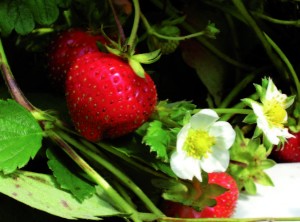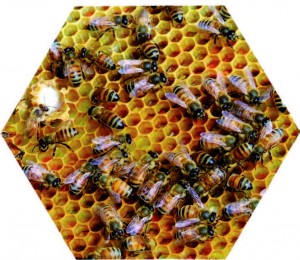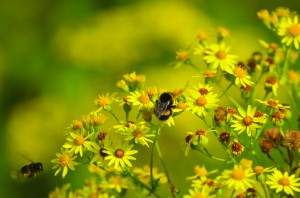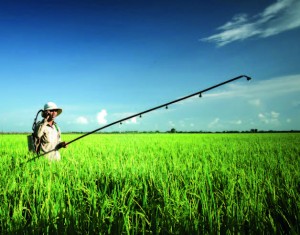MONDAY, 25 NOVEMBER 2013
"If the bee disappears from the surface of the Earth, man would have no more than four years to live”. A quote often misattributed to Einstein, likely to increase its gravitas given the real author’s anonymity, but one that certainly holds elements of truth regardless of its origin. Approximately 35 per cent of crops depend on petal-mediated pollination. This means that pollination events involving animal interaction need to have occurred for these crops to set fruit. Numbers of honeybees, domesticated or wild foraging, are highly important to food security because they provide the greatest proportion of this pollination. Whether or not the estimate of four years is wholly accurate is debatable, however, bee loss would surely lead to a grim outlook for crop production. This makes the recent two year ban on the use of three neonicotinoid insecticides by the EU that will come into force this December an important piece of legislature. But is this scientifically or politically motivated?Neonicotinoids are similar to nicotine, both in structure and in biological action, but are much more potent. As insecticides, their primary use is to control populations of crop pests, such as aphids or wood-boring beetles. Neonicotinoids affect the insect nervous system and can induce paralysis by binding to nicotinic acetylcholine receptors— proteins on the surface of neurons that sense the environment. They are much more effective at impacting this pathway in invertebrates than birds or mammals due to structural differences in the receptors, minimising possible side effects in humans and other animals.
Their mode of action is ‘systemic’ because they are absorbed and transported to all organs of the treated plant, and are therefore present within all tissues pests feed on. This systemic presence provides further benefits in reducing toxicity to other organisms as crop application can be achieved by methods other than spraying, for example as granules applied to soil. Consequently, they are generally seen as the most environmentally friendly insecticide because of their limited ‘off-target’ effects and relative ease of application. This has led to the recent increase in the use of this insecticide to around 20 per cent of the market.
The systemic nature of neonicotinoid action also means they can be potentially harmful to pollinators via pollen and nectar, even when applied outside the bloom period. This is due to the fact that following applications outside of the pollination season there is an indeterminable persistence of the insecticides within soil, which may later be taken up by plants. The most frequently used neonicotinoid is imidacloprid, which has a soil half-life of 40-200 days, depending on weather conditions. Other neonicotinoids have shorter half-lives, but on average persist for around 100 days. The precise determination of how long these insecticides remain in the environment following application is a key issue. The presence of neonicotinoids in pollen brought to the hive and stored within it, as well as in honey, has been detected by several studies. It appears that neonicotinoids can indeed persist in the pollen and nectar of crops, though concentrations can vary significantly and the effect on bee colonies remains obscure. Nevertheless, given that bee larvae feed almost exclusively on row—a complex mix of proteins and sugars—with pollen totalling only 5 per cent of their food consumption, it is unlikely that insecticides are the direct cause of colony collapse disorder. The problem lies in the sub-lethal effects that these substances can invoke in pollinators.
For the honeybee, the major impact of these insecticides at non-lethal doses is probably on navigation. There are some suggestions that action of these insecticides via nicotinic acetylcholine receptors impacts the bee ‘waggle-dance’, which is associated with the transfer of locational information to other foragers. In turn, the ability to navigate from the hive to food-rich areas is reduced, which diminishes colony fitness. Neonicotinoids could also impact on associative learning in honeybees, assessed by measuring proboscis extension in response to food. This is a vital part of successful foraging behaviours, as bees associate petal features with levels of reward over the flowering season. Significantly less work has been done on other pollinating insects due to their lesser economic importance, but it is apparent that not only honeybees are affected by neonicotinoids. For instance, several studies suggest that insecticides reduce food consumption and reproduction of bumblebees.
However, some of the studies that are held up as evidence to justify the imposed ban are irrelevant to the field. The most prominent example was a study that determined insecticide effects by direct application of imidacloprid and clothianidin to excised tissue of the bee nervous system. This kind of direct exposure is not a relevant possibility in the environmental setting, and the political motivation behind the use of such data in any decision is questionable. This raises the question of whether the political incentive to appease conservationists has played a role in hastening the legislation to ban these insecticides.
There are of course major economic problems invoked by the ban, due to the high usage of neonicotinoids. The vote to ban neonicotinoids was inconclusive, with the UK voting against a ban. The final decision was left to the European Commission, which imposed the ban as a “precautionary measure”. Nevertheless, alternatives with similar toxicity remain legal and are likely to become heavily used when the ban comes into force. For example, rapeseed is currently treated once with neonicotinoids before planting, which is sufficient to protect against the cabbage stem flea beetle, a particularly destructive pest of emerging seedlings. The use of neonicotinoids for this crop species increased, partly as a result of greater resistance to alternative insecticides. However, the ban will force farmers to return to older and less effective treatments, such as repeated pyrethroid foliage spray treatments. This insecticide has greater off-target effects and has been shown to be toxic to many pollinators, fish and other aquatic animals. Unfortunately, the sheer volume of populist attention that neonicotinoids received perhaps overshadowed the environmental impact of alternative insecticides for some major crops. As a result, the total environmental damage may in fact be greater as a result of the ban, even if pollinator numbers stabilise.
Another major problem is the large bias towards laboratory studies focusing on honeybees, primarily due to their key agricultural importance. However, recent work has identified that for 41 crop species, a rise in wild pollinator interactions increased fruit set twice as much as an equivalent rise in honeybee visitation. Consequently, the role of wild pollinators in any crop system appears to be underestimated. It is therefore necessary to further investigate the impact that these insecticides have on local vegetation such as neighbouring weeds, as well as on wild pollinators, before they can be safely reintroduced.
The use of neonicotinoids was encouraged because of their milder impact on other wildlife such as birds and mammals. Their widespread use however appears to have led to negative sub-lethal effects on pollinators that interact with plants adjacent to crop fields. The alternatives that some farmers will now be forced to turn to may be equally, if not more, environmentally damaging. The reality is that more studies into the long-term impact of neonicotinoids on wild populations are needed. We will have to wait for further research, but as a precautionary measure, a ban—even for political reasons—may be the most sensible immediate solution.
Greg Mellers is a 2nd year PhD student at the Department of Plant Sciences




